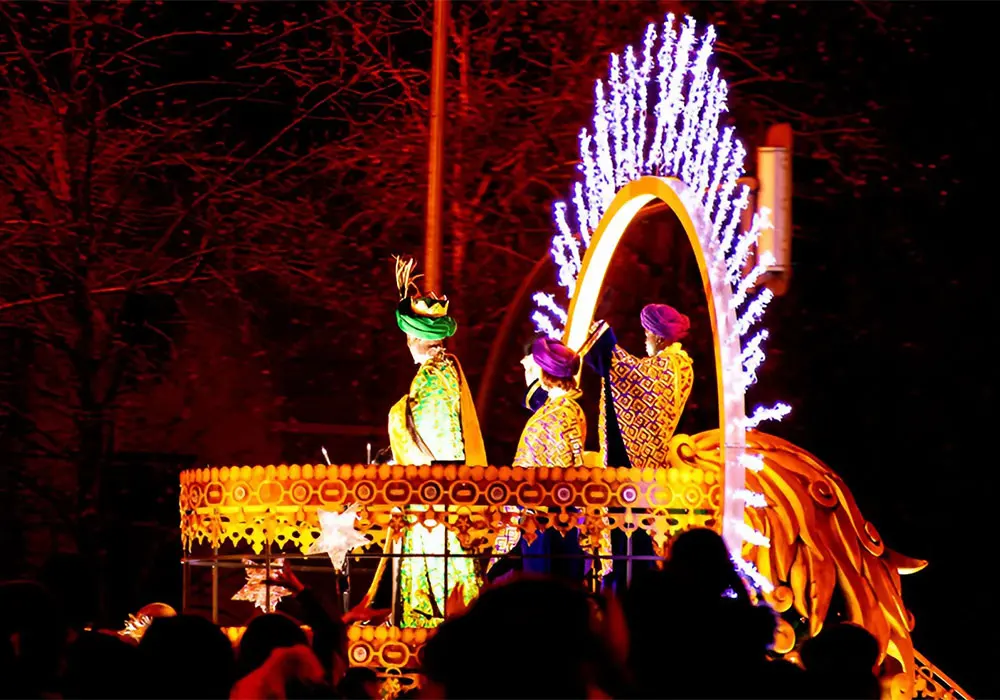
When it comes to Christmas, Spain does things a little differently. While festive lights, decorated trees, and family feasts are universal staples, Spanish holiday traditions include some truly unique practices that make the season extra magical.
Here’s a look at some of Spain’s quirkiest and most fascinating Christmas customs, perfect for adding a touch of Spanish spirit to your holidays!
- El Caganer: The Pooping Figurine

Yes, you read that right. In Catalonia, Christmas nativity scenes aren’t complete without a small figurine of el caganer, a cheeky character squatting in the corner doing his business. While it might sound irreverent, this centuries-old tradition is actually a symbol of fertility and good fortune for the year ahead. These figures often resemble famous personalities, adding a playful twist to the nativity setup.
- The Tió de Nadal: A Pooping Log
Sticking with Catalonia and pooping, meet Tió de Nadal, or “Christmas Log.” This wooden log, adorned with a painted face and a red hat, gets “fed” by children in the weeks leading up to Christmas. On Christmas Eve, the log is ceremoniously beaten with sticks while kids sing traditional songs, encouraging it to “poop” small presents and sweets. It’s a delightful mix of whimsy and tradition that brings families together in laughter.
- Olentzero: The Basque Santa Claus

In the Basque Country and Navarre, children eagerly await the arrival of Olentzero, a coal miner-turned-gift-giver. This cheerful figure, often depicted with a beret and pipe, is said to descend from the mountains to deliver presents on Christmas Eve. Parades and festivities celebrate his arrival, making Olentzero a charming alternative to Santa Claus in this region.
- The Living Nativity Scenes of Aragón
In Aragón, Christmas comes alive, literally, with belenes vivientes, or living nativity scenes. Entire villages, such as those in Alcanadre or Estadilla, transform into life-sized recreations of Bethlehem, with residents dressing as biblical characters. These immersive experiences include markets, carpenters, and even live animals, offering a uniquely Spanish take on the nativity story.
- The 12 Grapes of Luck

No Spanish New Year’s Eve (Nochevieja) is complete without the doce uvas de la suerte—twelve grapes of luck. At the stroke of midnight, Spaniards attempt to eat one grape with each chime of the clock. Successfully eating all twelve within the countdown is said to bring good fortune for the year ahead. It’s harder than it looks but guarantees plenty of laughs (and sometimes a bit of choking!).
- Zambombas in Jerez de la Frontera
In Andalusia, particularly in Jerez de la Frontera, Christmas wouldn’t be Christmas without zambombas. These traditional musical gatherings feature locals playing flamenco-inspired carols using a zambomba (a rustic drum-like instrument) along with guitars and clapping. These spontaneous street parties capture the warmth and joy of Andalucian culture, blending Christmas cheer with flamenco flair. In 2024, these run throughout the month of December.
- The Three Kings Parade

While Santa Claus is growing in popularity, Spain reserves its biggest celebration for the Reyes Magos (Three Wise Men). On the evening of January 5th, elaborate parades take over cities and towns, with floats, dancers, and sweets being tossed to eager children. In some places, camels carry the kings, adding a touch of biblical authenticity to the spectacle.
- La Fiesta de Santo Tomás in the Basque Country
On December 21st, the Fiesta de Santo Tomás marks the start of the festive season in the Basque Country. The fair celebrates rural traditions with livestock exhibitions, local crafts, food stalls, and traditional music. Locals don traditional dress, and the event is a colourful celebration of culture, farming traditions, and community.
- The “Fat One” Lottery
The El Gordo (The Fat One) lottery is a massive Christmas tradition across Spain. Families and friends pool their money to buy tickets, and the excitement builds as the numbers are drawn on December 22nd. The event is a national affair, with children from a Madrid school singing out the winning numbers in a melodious chant broadcast live on TV.
- The Day of Innocents (December 28th)
Spain’s answer to April Fool’s Day, El Día de los Santos Inocentes, is a day for pranks and jokes. But instead of pranking friends and family, some regions hold charity events where people “steal” goods to raise money for the less fortunate. It’s a lighthearted yet meaningful way to end the year.
- The Christmas Lights of Málaga

Málaga is known for its famous festive lights, particularly along Calle Larios, one of the city’s most iconic streets. The dazzling display transforms the area into a magical place. Thousands of sparkling lights are strung across the streets, and scheduled light shows to music bring thousands, locals and visitors alike, to experience the city’s festive magic.
- The Midnight Mass and Rooster Procession
Known as La Misa del Gallo (The Rooster’s Mass), the midnight Christmas Eve service is a cherished tradition throughout Spain. The name comes from the legend that a rooster crowed the night Jesus was born. In some villages, such as in Galicia, the service is followed by a symbolic rooster procession or even a real rooster being brought to the church, adding a unique rural touch to the celebrations.
Whether it’s swinging high in Seville, singing carols in Jerez, or scatological fun in Catalonia, Spain’s Christmas traditions offer a festive blend of humour, culture, and joy.
At TOMA & COE, we specialise in curating authentic experiences that bring you closer to Spain’s rich traditions, whatever the time of year, but for now…
¡Feliz Navidad!























